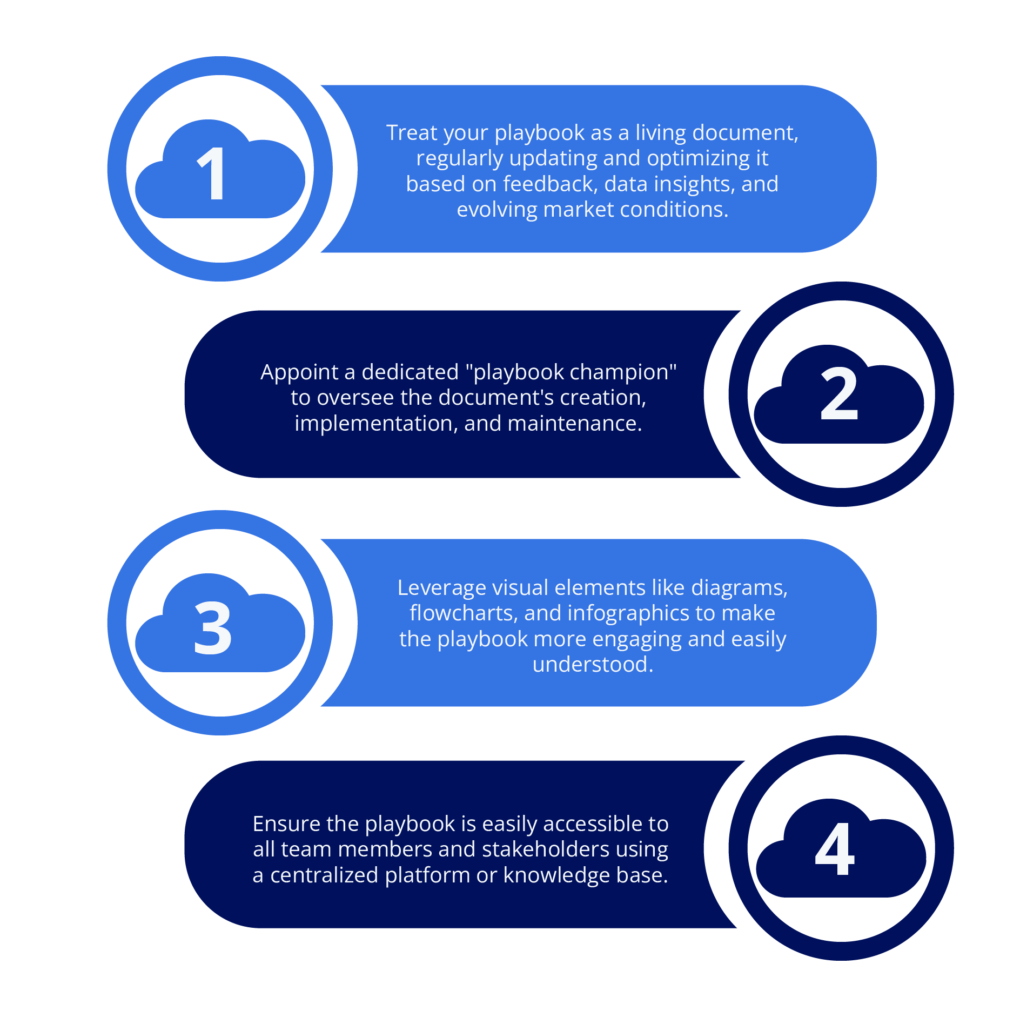Businesses constantly search for new and innovative ways to optimize their revenue-generating strategies and achieve sustainable growth.
One popular approach that has emerged in recent years is called Revenue Operations (RevOps).
Revenue Operations combines marketing, sales, and customer success teams under one unified framework. By doing so, it helps to break down silos, streamline processes, and leverage data-driven insights to drive revenue growth.
This blog post will explore scaling your business by adopting a RevOps model. We’ll discuss the critical components of a RevOps playbook and provide practical steps to help you implement a scalable RevOps strategy that can help take your business to the next level.
Why You Should Implement a RevOps Model
RevOps is a strategic approach that aims to optimize the end-to-end revenue process by aligning teams, workflows, data, and technology.
With this approach companies can optimize their revenue-generating processes, improve efficiency, and drive predictable results breaking down traditional silos between marketing, sales, and customer success teams to foster better communication, collaboration, and data sharing.
It enables businesses to optimize the entire customer lifecycle, from lead generation to customer retention and expansion, ultimately driving predictable and accelerated revenue growth.
A Forrester study found that organizations with a RevOps function reported nearly three times faster revenue growth than those without one. Public companies with a RevOps platform and team experienced 71% higher stock performance than their peers.
These findings highlight the transformative potential of RevOps in helping businesses scale and succeed in the current market.
How to Create a RevOps Playbook
A RevOps playbook is a comprehensive document that explains the strategies, processes, and best practices for aligning revenue-generating teams and driving growth.
Unlike traditional sales playbooks, which focus only on optimizing the sales function, a RevOps playbook takes a holistic view of the entire revenue cycle.
It defines the vision, objectives, metrics, roles, and responsibilities of all the teams involved, ensuring a unified and data-driven approach to revenue generation.
The main benefits of creating a RevOps playbook include:
- Ensuring consistency and alignment across revenue-generating functions.
- Delivering a seamless and exceptional customer experience throughout the buyer’s journey.
- Facilitating effective onboarding and training of new team members.
- Promoting the adoption of best practices and continuous improvement.
Key Components of a RevOps Playbook
To create a comprehensive and practical RevOps playbook, it is essential to include the following key elements:
- Overview of your RevOps function: Clearly define the purpose, challenges, key stakeholders, expected outcomes, and success metrics of your RevOps initiative.
- Company information: Provide a detailed overview of your organization, including your value proposition, target audience, products or services, and brand identity.
- Target audience: Develop detailed buyer personas that outline the demographics, pain points, goals, and preferences of your ideal customers.
- Products and services: Describe your offerings, pricing structure, and the unique value they provide to your target audience.
- Content assets: Curate and organize a library of relevant content assets, such as case studies, whitepapers, videos, and blog posts, to support the customer journey.
- Roles and responsibilities: Clearly define the roles, responsibilities, and skills required for each position within your RevOps team, ensuring clarity and accountability.
- Processes and workflows: Outline the end-to-end revenue process, including lead generation, qualification, nurturing, sales handoff, and customer success activities.
- Data and analytics: Establish a data strategy and governance framework, identifying key metrics, data sources, and analytics tools to support data-driven decision-making.
- Communication and alignment: Foster cross-functional collaboration through regular meetings, feedback loops, and knowledge sharing.
RevOps Playbook Best Practices
To ensure the success of your RevOps playbook, consider the following best practices:

Develop a Scalable RevOps Strategy in Five Steps
Developing a scalable Revenue Operations strategy is essential for businesses aiming to achieve sustainable growth and long-term success.
Creating a comprehensive plan that aligns marketing, sales, and customer success teams.
A well-designed RevOps strategy enables organizations to adapt to changing market conditions, capitalize on new opportunities, and continuously improve performance.
To develop a scalable RevOps strategy, businesses should follow these five essential steps:
- Define clear objectives and success metrics: To start, it’s essential to set goals that are specific, measurable, achievable, relevant, and time-bound (known as SMART goals) which are aligned with your overall business objectives. These goals should be centered around crucial areas such as revenue growth, customer acquisition, retention, and expansion. Moreover, you need to determine the key performance indicators (KPIs) that will assist you in tracking progress and measuring success.
- Assess your current state and identify gaps: Conduct a thorough assessment of your current revenue operations, including your team structure, processes, technology stack, and data management practices. Identify areas of strength and weakness and any gaps or inefficiencies that may hinder your ability to scale effectively. This assessment will provide a foundation for developing a targeted and actionable RevOps strategy.
- Align your teams and define roles and responsibilities: Foster cross-functional collaboration by aligning your marketing, sales, and customer success teams around a shared vision and common goals. Clearly define the roles and responsibilities of each team member, ensuring that everyone understands their contribution to the overall revenue process. Encourage open communication, knowledge sharing, and a culture of continuous improvement.
- Invest in the right technology and data infrastructure: Evaluate your current technology stack and identify any gaps or limitations hindering your ability to scale. Invest in a robust and integrated platform that enables seamless data flow, automation, and analytics across your revenue operations. Ensure that your teams have access to the tools and insights they need to make data-driven decisions and optimize their performance.
- Implement, monitor, and continuously optimize your strategy: After developing your RevOps strategy, it is important to implement it in a phased approach. Prioritize high-impact initiatives and quick wins for better results. Regularly monitor your progress against the defined KPIs and gather team feedback. Use these insights to refine and optimize continuously. You need the right team to strategize and adapt to new challenges and opportunities that may arise.
Leveraging Lead Scoring in Your RevOps Strategy
Lead scoring is an essential tool that can enhance the effectiveness of your Revenue Operations strategy.
It involves assigning numerical values to leads based on their probability of converting. By doing so, businesses can prioritize their efforts, allocate resources more efficiently, and accelerate revenue growth.
In the past, lead scoring was a manual process that involved using fixed rules and criteria. This method was prone to errors and was time-consuming.
Fortunately, with the introduction of AI-powered solutions and predictive analytics, businesses can now transform their approach to lead scoring.
By integrating advanced lead scoring capabilities into their RevOps strategy, companies can
- Focus on the most promising leads: Predictive lead scoring enables you to identify high-value prospects early in the buyer’s journey, prioritizing your engagement and nurturing efforts for maximum impact.
- Personalize your approach for better results: With more profound insights into lead behavior and preferences, you can tailor your messaging, content, and offers to resonate with each prospect, improving conversion rates and customer satisfaction.
- Optimize your resource allocation: By focusing on the leads most likely to convert, you can allocate your sales and marketing resources more efficiently, reducing waste and maximizing your return on investment.
- Align your teams around a common goal: Lead scoring provides a shared language and objective criteria for marketing, sales, and customer success teams to collaborate effectively, ensuring a seamless handoff and a unified approach to revenue generation.
To successfully leverage lead scoring in your RevOps strategy, consider the following best practices:
- Define your ideal customer profile and critical scoring criteria.
- Integrate data from multiple sources, including demographic, firmographic, and behavioral data.
- Regularly review and validate your scoring model to ensure accuracy and relevance.
- Ensure your lead scoring insights are accessible and actionable for all revenue-generating teams.
Conclusion
The adoption of Revenue Operations is growing, and business leaders must embrace this transformative approach and take action.
To succeed in an increasingly dynamic and competitive market, companies must develop a comprehensive RevOps playbook, foster a culture of collaboration and continuous improvement, and stay ahead of the curve regarding technology and best practices.
However, the true power of RevOps lies in the talent driving it. You need the right team to scale your business effectively with a RevOps model.
That’s where CloudTask comes in as your streamlined solution.
CloudTask Marketplace connects you with qualified remote sales professionals worldwide. With access to over 500 candidates specializing in RevOps, you can browse through video profiles, work histories, and monthly rates, streamlining your recruitment process significantly.








